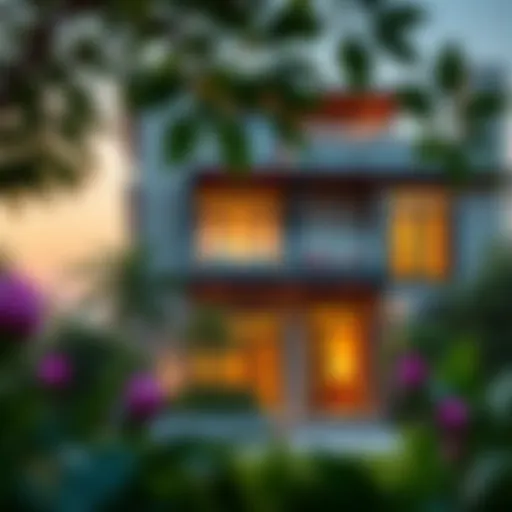Explore Dubai's Neighborhoods: Culture and Community
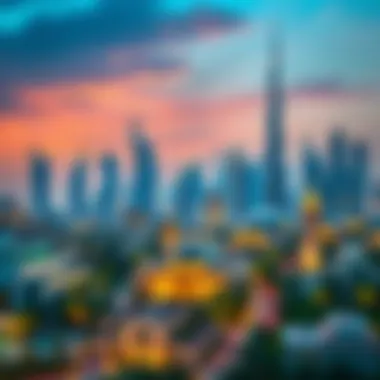
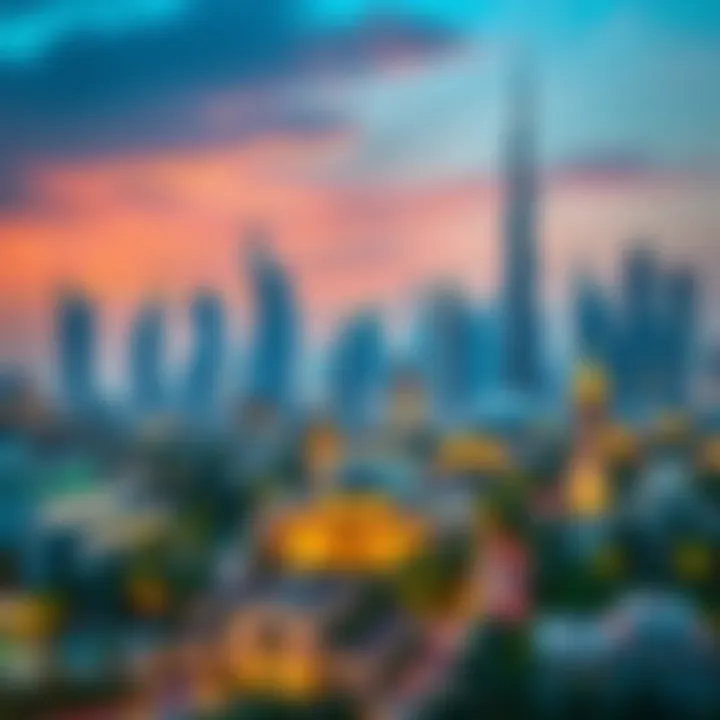
Intro
Dubai is a mosaic of neighborhoods, each possessing its own unique heritage and contemporary flair. For both residents and visitors, understanding the cultural, social, and lifestyle aspects of these areas can be akin to uncovering hidden treasures. This article traverses the vibrant streets and quiet corners of Dubai, guiding you through its diverse neighborhoods, rich in history and community spirit. Whether you’re a long-time resident, a newcomer, or just passing through, a deeper insight into these communities can significantly enhance your experience in this dynamic city.
Local Culture and Community
Dubai's neighborhoods are more than just geographic locations; they are living, breathing entities filled with stories and traditions. Here, the intersection of age-old customs and modern influences creates a rich tapestry of cultural experiences.
Cultural Festivals and Events
Throughout the year, Dubai's neighborhoods come alive with festivals celebrating cultural diversity. The Dubai Shopping Festival, for instance, not only offers incredible deals across various shops but transforms local areas into hubs of entertainment with live performances, fireworks, and community events. Meanwhile, Ramadan brings about a unique atmosphere—a blend of spirituality and social gatherings marked by Iftar events across different community centers, where people share meals and stories, reinforcing bonds.
Other noteworthy events include the Dubai Art Season, which permeates areas like Alserkal Avenue, showcasing local and international artists, inviting residents and tourists alike to participate in workshops and exhibitions. These communal experiences foster interaction and offer a glimpse of the city’s rich artistic landscape.
Community Engagement and Activities
Community engagement is crucial in Dubai, where expats and locals work side by side. The various community centers often host activities that encourage collaboration. For instance, in Jumeirah, residents frequently engage in beach clean-ups, fostering environmental awareness and a sense of shared responsibility amongst participants.
Regular book clubs and farmers' markets in neighborhoods like Mirdif also allow for meaningful interactions among residents, promoting a sense of belonging. Also, many cultural programs and workshops at local centers encourage cross-cultural dialogues and friendships that often extend beyond event timelines, embedding roots into the fabric of the neighborhood.
Lifestyle and Amenities
When it comes to lifestyle, Dubai’s neighborhoods cater to an array of preferences, making them a mix of modern conveniences and local traditions.
Dining and Culinary Experiences
Food is one of the best ways to experience local culture, and Dubai doesn’t disappoint here. In neighborhoods such as Deira, the Gold Souk isn’t just known for its vibrant marketplace; it’s surrounded by numerous eateries offering authentic Emirati dishes like shawarma and harees. The culinary offerings stretch to upmarket restaurants in neighborhoods like Downtown Dubai, where the dining scene features globally inspired cuisine curated by renowned chefs.
Whether it’s a bustling street-side café or a chic rooftop restaurant offering stunning views of the Burj Khalifa, the dining options are as varied as the people who call Dubai home.
Recreational and Entertainment Options
Entertainment opportunities abound too. Families flock to parks like Safa Park in the central areas for picnics and leisure activities. The neighborhood of Dubai Marina, with its breathtaking waterfront views, hosts a variety of boating and water sports, making it an ideal spot for adventurers.
In addition, various cinemas and entertainment centers scattered across neighborhoods provide a mix of the latest blockbuster films and local independent projects, reflecting the community’s vibrant film culture.
"Understanding the neighborhoods of Dubai is like peeling an onion, layer by layer, where each layer adds depth to your comprehension of this engaging city."
To delve deeper into each neighborhood, resources like Wikipedia provide valuable insights while local forums on Reddit can offer real-time advice from residents. Here's a chance to genuinely explore and engage with the richness that Dubai presents.
Intro to Dubai's Neighborhoods
Dubai, a bustling metropolis, is known for its extravagant skyline and rapid development. Yet, beyond the glitz and glamour of its skyscrapers lies a tapestry woven from distinct neighborhoods, each with unique stories, cultures, and lifestyles. Understanding these neighborhoods is crucial for anyone looking to truly experience Dubai, be it residents, expatriates, or tourists. Each area not only showcases a different facet of life in this city but also offers invaluable insights into the fabric of the community.
The Fabric of Dubai
The essence of Dubai's neighborhoods goes beyond mere geography; it's about the very fabric that binds its inhabitants. From the traditional souks in Deira to the luxurious beachfront villas in Jumeirah, every corner pulsates with life. This diversity fosters a sense of belonging among varied cultures, offering a rich platform for community interaction. The result? A culture that prides itself on hospitality and inclusivity. Residents, often hailing from different parts of the world, find not only a home but also a vibrant tapestry of experiences.
Imagine strolling through Al Fahidi, where historical structures whisper tales of Dubai's modest beginnings juxtaposed with the modern hustle of Dubai Marina, where tech-savvy professionals thrive amidst skyscrapers. This blend encapsulates the journey of a city that evolved from a modest fishing village to a global hub, demonstrating resilience, innovation, and harmony.
A Journey Through Cultural Diversity
Dubai's neighborhoods are like a kaleidoscope of cultures — each twist revealing new colors and patterns. While you might be sipping Arabic coffee at a quaint café in Jumeirah, just a stone's throw away, the rich spices and flavors of an Indian curry may waft from a local eatery in Bur Dubai.
This multicultural landscape is significant for several reasons:
- Cultural Enrichment: Exposure to various traditions and customs enhances the overall community experience. You might witness a vibrant Diwali celebration or Ramadan festivities, showcasing the city’s respect for diverse heritages.
- Economic Growth: Diverse neighborhoods contribute to the economic vitality of Dubai as they attract tourists and new residents alike, boosting businesses and fostering innovations.
- Social Cohesion: In areas like Al Quoz, art hubs thrive, exhibiting works from local and international artists, fostering dialogue and connections among the community members.
"Diversity in Dubai serves as a bridge, connecting people through shared experiences and mutual respect."
In summary, each neighborhood in Dubai is a testament to the city's diverse history and advances towards a modern future. Understanding these areas isn’t merely an exercise in geography; it’s a deep dive into the essence of life in Dubai, highlighting why each section deserves a closer look. As we progress, uncovering the historical context and exploring the districts' offerings, readers will gain a comprehensive view of what truly makes Dubai's neighborhoods unique.
Historical Context of Dubai's Communities
Understanding the historical context of Dubai's neighborhoods is akin to peeling an onion—layer after layer revealing the complexities and growth of a city that has transformed dramatically. By examining the past, one gains insights into the fabric that shapes Dubai today. It's the foundation upon which the diverse cultural mosaic is built; each strand of history represents different communities, values, and traditions contributing to the overall essence of modern-day Dubai.
This section delves deep into the early developments that laid down the roots along with the growth driven through trade and tourism, showcasing how these elements influenced not just the architecture and layout but also the very lifestyle of its inhabitants.
Early Developments and Settlements
The tale begins in the early 19th century when Dubai was but a small fishing village. Nestled along the shores of the Arabian Gulf, the settlement originated mainly due to its advantageous location, being ideally positioned along maritime routes. Around the late 1800s, families began to establish their homes, and the Al Maktoum dynasty took the reins of leadership, setting the stage for further developments.
Down by the Dubai Creek, you’d find sturdy dhows, wooden boats that are symbolic of Dubai’s past, sloshing about as they ferried goods and people. It painted a picture of a quaint town, with small trading posts blossoming along the creekside, allowing local merchants to begin trading with surrounding regions. What was once a simple haven for fishermen gradually grew into a bustling marketplace where commerce became the lifeblood.
- Key Factors in Early Settlement:
- Water Supply: The creek provided essential water supply for both drinking and agriculture.
- Protection and Shelter: The site was easily defensible, which attracted early settlers seeking safety amidst regional conflicts.
- Trade Opportunities: Proximity to other trading hubs increased the demand for local goods, encouraging economic activities.
The rapid yet organic growth was a response to both internal and external factors. With pearl diving becoming an increasingly lucrative venture, these expansions would lead to further developments, including the establishment of schools and mosques, which became pivotal to community life. Dubai started to shape its identity, reveling in its cultural uniqueness driven by diverse influences.
Growth through Trade and Tourism
The winds of change picked up pace after the discovery of oil in the mid-20th century, but this narrative wouldn’t be complete without recognizing an earlier form of wealth—trade. Despite not having the same kind of mineral wealth as other Gulf states, Dubai’s geographical advantages and heritage as a trade hub meant that it became a focal point for commerce well before the oil boom.
During the 1950s, markets like the spice and gold souks drew visitors by the droves, profoundly influencing the local economy and culture. Tourists came not only to buy but also to experience the unique blend of tradition and modernity. Investment in infrastructure followed, ensuring that the influx of visitors was met with suitable amenities and services that could handle the growing demand.
- Influences on Growth:
- Expansion of Trade Routes: Increased shipping routes expanded global connections, attracting merchants from far and wide.
- Development of Tourism: Launch of iconic attractions began in the late 1990s attracted visitors looking for luxury and adventure alike.
- Cultural Exchange: Growing interactions led to a richer cultural tapestry, with traditions blending from various parts of the globe.
As the economy diversified away from being solely reliant on oil, Dubai has become a showcase for unparalleled growth through tourism and trade. This easy coalescence of old-world charm with modern skyline transformations is a testament to the city’s ongoing journey—an evolution continuing to attract and embellish narratives that define communities today.
"Understanding Dubai’s past assists in navigating its present and future. Each neighborhood tells its own story, shaped by trade, culture, and time."
These neighborhoods—each a reflection of its unique historical roots—offer a guide to how shared histories create vibrant community lives today. In the next sections, we will explore how these communities have embraced modernity while holding on to their past, fostering an environment of acceptance and growth.
Distinct Character of Each Neighborhood
The neighborhoods in Dubai showcase a distinct personality that is molded by their unique histories, cultural influences, and socioeconomic dynamics. Understanding this character is pivotal for both residents and visitors who wish to grasp the essence of what makes each locale special. From the vibrant streets of Old Dubai, steeped in tradition, to the opulent towers of New Dubai, one finds a fascinating interplay between the past and the future.
The distinct character of each neighborhood not only serves as a symbol of Dubai's progress but also as a reflective mirror of its community's identity. For someone planning a visit, knowing these details can elevate their experience, allowing them to navigate beyond the tourist trail into realms that truly represent Dubai's heart.
Old Dubai: Cultural Heritage and Tradition
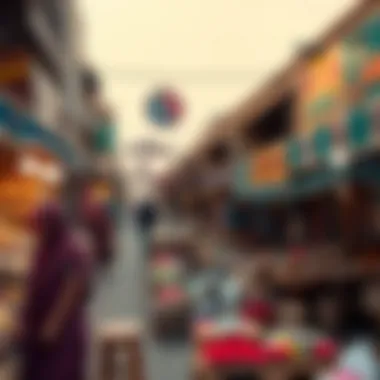
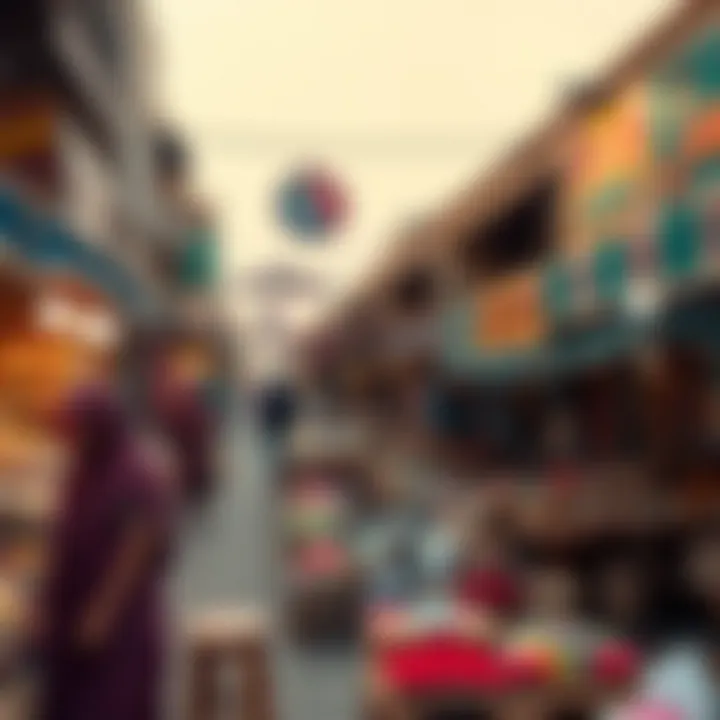
Old Dubai epitomizes the very soul of the emirate. Here lies the humble beginnings of a once-sleepy fishing village that evolved into a thriving cosmopolitan city. Wander through Al Fahidi Historic District, where winding lanes are lined with beautifully preserved wind-tower architecture. The Dubai Museum, housed in the Al Fahidi Fort, serves as a reminder of this area’s rich heritage, offering a glimpse into the daily lives of its past inhabitants.
In Old Dubai, the cultural mosaic is most apparent. Markets, or souks, buzz with activity: the spice souk delights the senses with exotic aromas, while the gold souk shimmers with its dazzling offerings. Islam is central here; traditional practices are respected and celebrated, enhancing the area's character. Festivals, art exhibitions, and community gatherings are just a few examples of how these neighborhoods actively engage their heritage, ensuring that tradition continues to thrive amidst change.
Cafés and eateries serving authentic Emirati cuisine can be found interspersed among these historical sites, allowing visitors to indulge in flavorful dishes such as Al Harees or Majboos. It's a culinary journey that tells a story of culture and familial connections, making Old Dubai a vital part of the city’s narrative.
Modern Dubai: A Fusion of Innovation and Luxury
In stark contrast stands Modern Dubai, manifesting the city's ambitions in steel, glass, and innovation. The iconic Burj Khalifa dominates the skyline, a testament to architectural prowess and fiscal strength. This neighborhood represents the dream realized, blending luxury living with cutting-edge technology. It is a playground for the elite, complete with lavish shopping malls such as The Dubai Mall and breathtaking attractions like the Dubai Fountain.
However, it is not all about luxury; the character of Modern Dubai also lies in its forward-thinking communities. The areas around Dubai Marina and Jumeirah Beach Residence are alive with vibrant lifestyles where fine dining, trending cafés, and recreational activities merge seamlessly. The architectural style here reflects a modern ethos of design and sustainability, highlighting how urban developments can be beautiful yet functional.
Community engagement thrives through events like the Dubai Shopping Festival and art exhibitions that fill the streets with life and creativity. Even the parks in this area, such as Zabeel Park, showcase the importance placed on green spaces in a growing metropolis. For residents and tourists alike, Modern Dubai offers a blend of excitement and leisure that reflects Dubai’s ever-evolving identity.
The distinct neighborhoods of Dubai not only define its visual landscape but also its cultural fabric, interweaving tradition with modernity in fascinating ways.
Culinary Landscape Across Neighborhoods
The culinary landscape of Dubai is as diverse and vibrant as its population. As you meander through the various neighborhoods, each area offers a unique flavor profile that caters to locals, expatriates, and tourists alike. Understanding this culinary diversity can enhance your experience, whether you are a resident looking to discover your new favorite spot or a visitor trying to soak in the culture.
From bustling street markets with sizzling food stalls to lavish dining establishments that serve gourmet dishes, the culinary offerings reflect the melting pot that is Dubai. This section delves into the heart of Dubai's food culture, highlighting the significance of its neighborhoods on the culinary map and the experiences that await.
Street Food Gems in Local Markets
When one thinks of Dubai, the high-rise skyline often overshadows its rich street food culture. However, stepping into the local markets is like diving into a treasure trove of flavors. You can find key spots like the Deira Market or Al Karama where the aroma of spices wafts through the air, inviting you to try the offerings.
Here are a few gems worth discovering:
- Shawarma Stalls: No trip to Dubai is complete without savoring shawarma. Local vendors wrap up marinated meat in soft pita bread, topped generously with garlic sauce and pickled veggies. They serve it hot and fast, perfect for a quick meal on the go.
- Falafel Booths: For something vegetarian, falafel is a staple. Freshly fried, these chickpea patties are crunchy outside while soft and fluffy inside — they pack quite a punch in flavor when paired with a tangy tahini sauce.
- Chaat Stands: Influenced by the Indian subcontinent, these stands serve a variety of savory snacks, from bhel puri to pani puri. They embrace bold, spicy flavors that dance on the taste buds.
These street food options not only offer a taste of Dubai’s rich tapestry but also enrich the cultural experience. The informal settings often lead to interactions with friendly vendors who share stories and recommendations, making each bite memorable.
High-End Dining Experiences
On the flip side, Dubai is also home to a burgeoning fine dining scene that attracts culinary enthusiasts from all over the world. The city showcases numerous high-end restaurants that are helmed by world-renowned chefs, presenting an array of gourmet experiences. Here are some standout choices:
- At.mosphere: Located on the 122nd floor of Burj Khalifa, this social dining venue offers a menu that speaks of elegance. The panoramic views combined with culinary artistry create an unforgettable dining experience.
- Nobu: Famed for its fusion of Japanese and Peruvian cuisines, Nobu in the Atlantis, The Palm, offers dishes like black cod miso that are a must-try. The ambiance here is stylish and lively, making it perfect for a special occasion.
- La Petite Maison: Situated in the Dubai International Financial Centre, this restaurant serves fresh, Mediterranean-inspired dishes that burst with flavors. The focus on quality ingredients and presentation is evident in every bite.
Each of these establishments not only serves exceptional food but also offers a glimpse into Dubai’s luxurious lifestyle. The high-end dining scene caters to those looking for upscale experiences coupled with top-notch service.
"The food experience in Dubai is not just about nourishment; it's an exploration of cultures, tradition, and innovative culinary techniques that bring together the old and new of this fascinating city."
Recreational and Lifestyle Amenities
Recreational and lifestyle amenities play a crucial role in the livability of Dubai's neighborhoods. These amenities provide not only a vibrant atmosphere but also contribute significantly to the health and wellbeing of residents and visitors. With a variety of options, from parks to fitness centers, each neighborhood reflects its unique character while catering to various lifestyle needs. Fostering a sense of community and connection, they are essential for both social interaction and personal growth.
Parks and Public Spaces
Dubai boasts numerous parks and public spaces that serve as the lungs of the city, providing essential green areas amid the urban landscape. The availability of parks is important because they offer a respite from the bustling environment. For example, Al Barsha Park is a popular spot featuring lush gardens, jogging paths, and children's playgrounds. The tranquil lakes and open areas are perfect for families looking to spend quality time outdoors.
Additionally, public spaces like Safa Park encourage community gatherings, allowing for picnics and recreational events. These parks aren't just patches of greenery; they are well-maintained oases where residents can unwind and recharge. Some amenities found in these parks include:
- Walking and jogging tracks
- Sports facilities like tennis and basketball courts
- Children’s play areas
- Picnic spots with lush lawns
With seasonal events or small festivals often held in these venues, they truly act as communal hubs for local residents and tourists alike. Not to mention, they foster health and wellness through outdoor activities.
Fitness and Wellness Facilities
In recent years, Dubai has seen a growing emphasis on health and wellness, with numerous fitness facilities popping up across neighborhoods. These fitness centers range from high-end gyms like Fitness First to community-focused studios where people can join group classes. Residents benefit from a variety of fitness options tailored to different fitness levels and interests.
Moreover, wellness facilities that promote holistic health, such as yoga studios and meditation centers, are becoming increasingly popular. This holistic approach to fitness allows individuals to focus not only on physical health but also on mental wellbeing.
Some notable facilities include:
- Community gyms equipped with modern exercise machines
- Outdoor workout spaces with fitness stations
- Specialized studios for yoga, pilates, and dance
These facilities are more than just places to work out; they are centers for fostering a shared commitment to healthy living. Many also offer classes that encourage social interaction, breaking down barriers among diverse groups.
As a result, a resident's engagement with recreational and wellness spaces significantly shapes their overall living experience in Dubai. Whether it's a quick jog in a neighborhood park or an afternoon spent in a local fitness class, these amenities contribute immensely to a balanced lifestyle.
Community Engagement and Activities
Engagement within a community isn’t just about living close to one another; it’s about weaving a fabric of relationships that enrich daily lives. In Dubai, community engagement and activities play an essential role in fostering connections between residents, expatriates, and tourists alike. It’s how one finds common ground in a city bustling with life. This section highlights the significance of these elements in building a thriving urban ecosystem, giving insight into the vibrant spirit that defines Dubai's neighborhoods.
Cultural Festivals and Events
Dubai stands as a mosaic of cultures and traditions, and it comes alive through various cultural festivals and events held throughout the year. These celebrations, often rooted in the diverse backgrounds of its residents, offer a rare glimpse into the rich tapestry of experiences that dwell in the city. Events such as the Dubai Shopping Festival and the Dubai Food Festival draw crowds from all walks of life, offering entertainment, cuisine, and arts that reflect the city's multicultural essence.
Participating in local festivals allows residents and visitors to appreciate the multifaceted identities that coexist within the emirate. Take, for example, the Dubai International Film Festival. It not only showcases local and international filmmakers but also brings together an audience who shares a passion for cinema. Similarly, the Dubai Art Season is a feast for the senses, featuring art from local and global artists in its vibrant galleries and public spaces.
These events often foster a sense of belonging among participants, diminishing the feeling of isolation that can come with city living. It’s a way to step beyond the comforts of home and shoulder-to-shoulder engage with others.
"Community festivals are more than just dates marked on a calendar; they are moments that punctuate our experiences in the city, stitching people into the rich quilt of our neighborhoods."
Volunteer Opportunities
Beyond festivals, volunteer opportunities in Dubai allow individuals to make a meaningful impact. They foster a sense of purpose and responsibility towards the community. Organizations such as the Dubai Cares and Emirates Red Crescent offer various initiatives that rely on community involvement—from educational programs to disaster relief efforts.
Engaging in volunteer work not only benefits those you help; it can also transform the volunteer. When people give their time to causes they care about, it often leads to personal growth, friendships, and network expansion. For instance, volunteers at food banks like Food Bank Dubai not only assist in food distribution but often engage in workshops that help them learn about food security and sustainability.
The chance to work alongside individuals with a shared commitment fuels a collaborative spirit, reinforcing the idea that communities are at their best when everyone contributes. This engagement often leads to lasting friendships, making it easier for newcomers to integrate into their neighborhoods.
In summary, the importance of community engagement in Dubai is clear; be it through festivals or volunteering, these activities form the backbone of social interaction. They invite participation, cultivate relationships, and encourage a sense of pride in one’s community, ultimately painting a fuller picture of life in this thriving international metropolis.
Education and Healthcare Services
When digging into the essence of Dubai, two pillars stand tall: education and healthcare services. These facets play a crucial role in shaping the quality of life in the emirate. For residents, expatriates, and tourists alike, understanding the educational landscape and healthcare options is essential. Not only do they affect personal growth and wellbeing, but they also contribute significantly to the community as a whole.
Schools and Learning Institutions
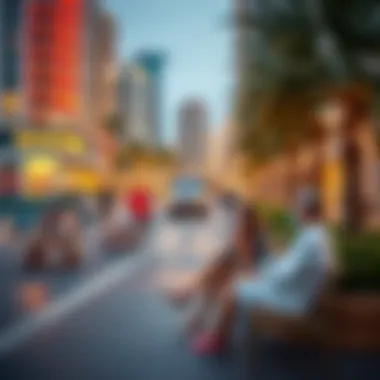
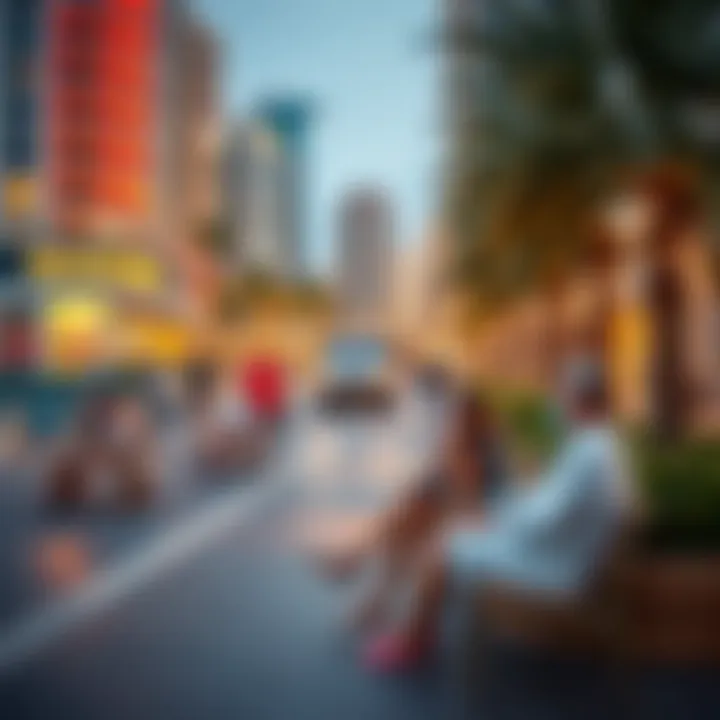
Dubai boasts a diverse array of educational institutions, catering to various curricula from British, American, and International Baccalaureate to national systems from around the globe. Every neighborhood seems to have schools that mirror the cultural tapestry of the city. For expatriates, this is particularly comforting, as they can find familiar educational frameworks for their children.
- Quality of Education: The UAE Government maintains strict regulations to ensure high standards in schools. Regular inspections by the Knowledge and Human Development Authority (KHDA) keep the educational institutions on their toes, striving for excellence.
- Extracurricular Activities: Schools in Dubai often focus on holistic development. These institutions encourage sports, arts, and other extracurricular activities, allowing students to bloom beyond academics. Whether it is learning to play guitar, joining a football team, or participating in a robot-building competition, the options are boundless.
- Cultural Sensitivity and Inclusion: Many schools emphasize the importance of cultural sensitivity and inclusion, creating an environment where children learn from one another's diverse backgrounds. For example, schools frequently organize International Days, where children share their heritage through food, music, and attire, fostering an atmosphere of respect and understanding.
It’s interesting to see how schools have become community hubs, where parents also engage, fostering a network of support. The Dubai British School and American School of Dubai are just a couple examples where such cultures thrive, allowing families to integrate into the fabric of society.
Hospitals and Medical Facilities
When health is on the line, Dubai does not pull its punches. The healthcare system here is a well-oiled machine, known for its high standards and advanced technology. Public hospitals like Dubai Hospital offer a range of services, while prestigious private facilities like Cleveland Clinic Abu Dhabi deliver specialized care.
- State-of-the-Art Facilities: The emirate is home to some of the best healthcare facilities in the world. Many hospitals have accreditation from international organizations, making them reliable options for medical tourism as well.
- Insurance Coverage and Accessibility: Health insurance is mandatory in Dubai, so residents often find selections of plans that fit their needs. This requirement not only assures affordability but also supports accessibility to quality care.
- Preventive Health Programs: There is a strong emphasis on health education and preventive programs. Regular health fairs and awareness campaigns are held in communities, supporting the residents’ commitment to proactive health management.
Having easy access to exceptional healthcare can be quite reassuring, especially for expatriates who might feel out of sorts in a foreign country. Knowing that high-quality medical attention is just around the corner establishes a significant sense of security.
"Education is a passport to the future, for tomorrow belongs to those who prepare for it today."
As Dubai moves forward, its commitments to education and healthcare will continue to build a robust community. Residents can appreciate not just the physical spaces but also the relationships formed through schools and hospitals, making Dubai a truly vibrant city.
Transport and Accessibility
The way people move around has a profound impact on daily life in a city as sprawling and dynamic as Dubai. Well-planned transport and accessibility systems play a pivotal role in shaping not just how residents and visitors navigate from point A to B, but also in defining the overall living experience. In a city renowned for its opulence and modernity, understanding transport options is essential for anyone who plans to explore its multifaceted neighborhoods. Efficient public transit systems, road networks, and innovative connectivity solutions make it possible to enjoy everything Dubai has to offer, from bustling markets to tranquil parks.
Public Transportation Systems
Dubai has invested heavily in developing an efficient public transportation network that reflects its commitment to sustainability and accessibility. The Dubai Metro, which began operations in 2009, is perhaps the star of this system. With lines stretching across the city, it provides a convenient means for residents and tourists alike to hop on and off at major attractions such as the Burj Khalifa and the Mall of the Emirates.
But that’s not all. The tram system, too, has been a recent boon. Connecting areas like Dubai Marina to the metro and surrounding locales, it ensures that neighborhoods remain interconnected and easily navigable. The city’s expansive bus network complements these rail options, offering extensive routes that allow for access to more remote areas.
In addition to these services, many of the traditional methods of transport still thrive. The age-old abra ride on Dubai Creek is not only a gorgeous way to travel but serves as a link between older and newer parts of the city.
- Key Features of Public Transportation:
- Affordability: Most options are budget-friendly.
- Time Efficiency: Regular schedules mean less waiting.
- Accessibility: Facilities exist for those in need of assistance.
As a traveler or resident, understanding these systems ensures you make the most of your time. While cars remain common in Dubai, utilizing public transport can enhance the experience and relieve some of the traffic burdens, particularly during peak hours.
Connectivity between Neighborhoods
Dubai's neighborhoods are remarkably diverse, each offering unique cultural flavors and experiences. Therefore, effective connectivity is not just about getting from one place to another; it’s about threading the rich tapestry of community experiences together. Major roads, like Sheikh Zayed Road, serve as arteries that connect the different districts, facilitating easier transitions from the commercial bustle of Downtown to the serene vibes of Jumeirah or the artistic flair of Al Quoz.
- Importance of Connectivity:
- Innovative Solutions: For those who prefer more unconventional travel options, ride-sharing apps such as Careem and Uber are widely used in the city, offering flexibility for those on tight schedules or in need of more direct routes.
- Cultural Exchange: Ease of movement encourages mingling between local and expatriate communities, fostering cultural exchange.
- Economic Activity: Seamless transport options benefit local businesses and the overall economy by driving customers from one neighborhood to another.
"The rich interconnection of neighborhoods in Dubai transforms a single trip into a journey through a vibrant cultural landscape."
In sum, the transport and accessibility landscape in Dubai is both impressive and pragmatic. It plays a critical role in shaping the experience of living in or visiting the city, ensuring that both residents and tourists can explore and appreciate the unique offerings of each neighborhood with ease.
Commercial and Retail Landscape
The commercial and retail landscape of Dubai is a vital part of its identity, shaping how residents, expatriates, and tourists interact with the city. In a metropolis where modernity meets tradition, the array of shopping options plays a pivotal role in the daily lives of its inhabitants. From sprawling malls that offer luxury brands to vibrant local markets rich in cultural heritage, every neighborhood has its unique shopping flavor. This section dives into the two contrasting elements of Dubai’s retail scene: shopping malls and local markets, as well as the charm of unique boutiques and artisans sprinkled throughout the city.
Shopping Malls vs. Local Markets
Shopping malls in Dubai have become synonymous with opulence. Iconic venues such as The Dubai Mall not only provide shopping opportunities but also a plethora of entertainment options like aquariums, indoor skating, and even virtual reality adventures. It’s almost like a city within a city. The high-end allure caters to those searching for the latest in fashion or technology, enticing visitors with international brands that are hard to come by elsewhere.
On the flip side, local markets or souks present a more authentic shopping experience that’s steeped in culture. The Gold Souk, known for its dazzling displays of jewelry, and the Spice Souk with rich aromas of spices and herbs, showcase a different side of Dubai. Shopping here is not just about the transaction; it’s an immersion into the local culture.
- Benefits of Shopping Malls:
- Advantages of Local Markets:
- Comprehensive offerings under one roof.
- Controlled environment protecting against climate.
- Luxury brand experience;
- Cultural experience and authenticity.
- Opportunities for haggling and finding unique items.
- Support for local artisans and businesses.
Both shopping malls and local markets have their charm and bring variety to Dubai's commercial scene. Despite their differences, each plays a key role in reflecting the city’s dynamic nature.
Unique Boutiques and Artisans
Amidst the towering skyscrapers and vibrant market stalls, unique boutiques and skilled artisans add an irreplaceable touch to Dubai’s retail tapestry. In areas like Al Quoz, you can find artistic spaces and gallery-like shops selling handcrafted items. These boutiques often tell stories, showcasing creativity and craftsmanship that stand apart from mass-produced goods.
An artisan’s creation can range from ceramic pottery to intricate textiles. Such items serve as perfect souvenirs for tourists or thoughtful gifts for friends back home.
- Examples of Unique Offerings:
- Custom-made jewelry from local artisans.
- Handwoven carpets from skilled weavers.
- Artistic prints that capture Dubai's skyline.
"Dubai's commercial heart beats where luxury meets cultural heritage. Shopping here is not just about acquiring things; it’s about collecting memories and experiences."
Explore more about Dubai’s retail offerings in resources like Wikipedia, or visit The Dubai Mall website.
For insights into local markets, check out local.travel.com for an updated guide moving through the vibrant souks.
Living Trends in Dubai's Neighborhoods
Understanding the living trends in Dubai’s neighborhoods is critical for anyone looking to settle down or navigate this vibrant city. The combination of diverse cultural influences, rapid urbanization, and innovative community designs create a dynamic living environment. Each neighborhood offers something unique, contributing to a larger narrative that reflects Dubai's ongoing evolution.
From high-rise luxury apartments in places like Dubai Marina to more traditional villas in Jumeirah, housing options are abundant. However, it's not just about where to live. The social fabric within these communities is key. Whether you’re a local preparing for a family or an expatriate searching for a temporary base, knowing the living trends can greatly enhance your experience.
Rental Markets and Property Insights
Dubai’s rental market is an ever-changing landscape shaped by economic trends and demographic shifts. In recent years, the demand for property has surged among expatriates and locals alike. Areas such as Downtown Dubai and Palm Jumeirah command higher rental prices due to their luxurious amenities and prime locations. Conversely, neighborhoods like Al Qusais and Dubai Silicon Oasis present more budget-friendly options, making them appealing for younger professionals and families.
Factors affecting rental prices span from proximity to major transport links to the availability of community services. Landlords often look for tenants who can prove their reliability through documentation. This means that presenting a solid rental application is essential, especially in competitive neighborhoods.
In addition, many apartments in Dubai come with state-of-the-art facilities, which can influence the decision-making process for potential renters. A gym, pool, or even on-site retail services can significantly enhance living standards.
"The rental market in Dubai is like a seesaw; it can tip quickly based on economic conditions and seasonal demand."
Community Living and Shared Spaces
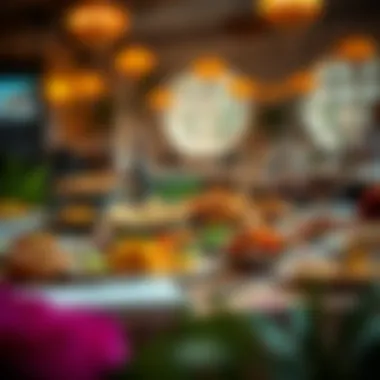
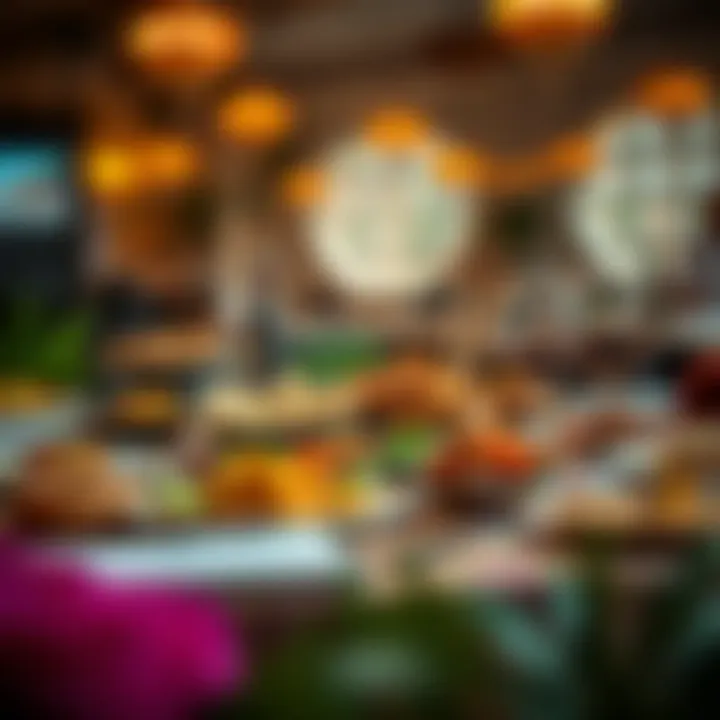
The rise of community living in Dubai highlights a growing trend towards shared spaces that promote interaction. Facilities like community centers, parks, and communal gardens are designed to foster a sense of belonging among residents. For instance, Arabian Ranches and The Springs are known for their superb community facilities, where families can enjoy a range of activities together.
Shared spaces serve not only as leisure areas but also as platforms for community engagement. Regular events, farmer’s markets, and workshops encourage residents to connect. This is particularly significant for expatriates who might feel isolated. Building friendships in these communal settings eases the transition to a new culture and creates longstanding networks.
Furthermore, the emphasis on community living aligns with Dubai’s larger commitment to enhancing the quality of life. The idea is that by integrating green spaces and cooperative areas, it helps cultivate a healthier, happier population.
Epilogue
In sum, the living trends that characterize Dubai’s neighborhoods exhibit a fascinating interplay of culture, community, and convenience. No matter what corner of Dubai you explore, understanding the rental markets and the importance of shared spaces can profoundly affect your experience in this city. The options are plentiful, and there is no singular path in navigating this vibrant metropolis. Whether you seek luxury or community, the opportunities await all who step into these neighborhoods.
Environmental Considerations
Environmental considerations play a crucial role in ensuring that Dubai’s rapid growth and urban development align with sustainable practices. This necessity arises not only from the city's strategic positioning in a blistering desert climate but also from its aspiration to be a global leader in both innovation and sustainability. Given the ongoing global dialogue about climate change, understanding how Dubai manages these environmental challenges offers valuable insights into the future of urban living.
Sustainability Initiatives
The city of Dubai has initiated a range of sustainability initiatives that reflect its vision for eco-friendly growth. For instance, the Dubai Clean Energy Strategy 2050 aims to make Dubai a global center for clean energy and green economy. This overarching goal embraces numerous projects:
- Solar Energy Projects: With the Mohammed bin Rashid Al Maktoum Solar Park at its helm, Dubai strives to increase the share of renewable energy to 75% by 2050. This park, often referred to as the largest single-site solar park in the world, contributes immensely to the local energy grid.
- Green Building Regulations: The implementation of the Dubai Green Building Code mandates that new buildings conform to sustainable practices. This code covers energy and water efficiency, minimizing electrical consumption, and using materials that reduce environmental impact.
- Waste Management Programs: Clean Dubai's efforts in waste management focus on recycling and minimizing landfill. Programs like ‘Recycle right’ encourage residents to sort their waste, making it easier to promote recycling and waste diversion.
These initiatives not only aid in environmental preservation but also cultivate community pride and a sense of responsibility toward conserving natural resources.
Public Awareness and Education
Creating a culture of sustainability requires effort beyond just implementing policies; it calls for an educated community. Public awareness and education are pivotal components of Dubai’s environmental strategy. The local government works diligently to engage citizens through various programs and campaigns:
- Educational Workshops: Events focused on educating the public about sustainable practices have gained traction. Various organizations, including governmental bodies and NGOs, often collaborate to host workshops aimed at teaching residents how to adopt environmentally-friendly habits in their daily lives.
- School Programs: Schools in Dubai are integrating environmental education into their curriculums. By fostering eco-consciousness from a young age, the city's future generation becomes more aware of their ecological footprint.
- Community Events: Initiatives like the ‘World Cleanup Day’ bring residents together to clean public spaces and foster a sense of community responsibility. Through such collective actions, citizens learn about waste management and the importance of maintaining a clean environment.
“Building a sustainable community is not just about green technology, but also about changing hearts and minds.”
Social Dynamics and Cultural Norms
Understanding the social dynamics and cultural norms within Dubai is crucial for navigating its vibrant neighborhoods and appreciating the diversity that makes this city unique. This metropolis is home to a melting pot of cultures, represented by a tapestry of different communities coexisting side by side. One of the key elements of Dubai's charm lies in its effective blend of traditional values deeply rooted in Emirati culture with modern influences brought in by expatriates from around the world.
Residents, expatriates, and tourists alike can benefit immensely from grasping the local customs and societal expectations. Not only does this knowledge foster harmonious relationships, but it also enriches personal experiences while exploring the city. It's fascinating to observe how Emiratis maintain their cultural heritage, such as the art of falconry and traditional dance, while regularly participating in global trends and initiatives in various neighborhoods.
Understanding social dynamics goes beyond simply learning about customs; it involves recognizing how interpersonal interactions can vary across different groups. Greetings, for example, can differ significantly. In one neighborhood, you might find a casual handshake, while in another, a warm embrace or a nod carries more significance. Paying attention to these nuances can enhance the connections made between individuals from different backgrounds.
Cultural Sensitivity and Respect
Cultural sensitivity in Dubai is not just advisable; it's essential. The importance of respecting differences cannot be underestimated, especially in a city built on hospitality and multiculturalism. Taking time to understand and appreciate what matters to your neighbors can pave the way for positive relationships.
For instance, during Ramadan, a month of fasting for Muslims, non-Muslim residents and tourists should be mindful of those who are observing this sacred period. Eating and drinking in public during the daylight hours might be seen as disrespectful. To honor local traditions, one can choose to indulge in meals after sunset, thus demonstrating respect for cultural practices.
Even small gestures can speak volumes. Using common Arabic phrases, such as "Salam Alaikum" (peace be upon you), can create an instant rapport.
“In a city like Dubai, understanding the cultural fabric strengthens community ties and enhances social harmony.”
Integrating Diverse Communities
Integrating diverse communities is another vital aspect of Dubai’s social landscape. Neighborhoods serve as hubs of interaction and understanding, where various cultures intersect. For example, in areas like Jumeirah and Al Wasl, you'll find a significant Emirati presence alongside expatriates from South Asia, Europe, and beyond. Such mingling offers a rich array of perspectives.
A series of community events, festivals, and initiatives are regularly organized to emphasize unity among different groups. For example, the Dubai Shopping Festival celebrates not just commerce, but the diverse tapestry of cultures present in the city. It’s a fantastic opportunity for individuals of diverse backgrounds to showcase their culinary traditions, music, and dance forms, all while learning about each other’s heritage.
Collaboration plays a significant role in encouraging inclusiveness. Community centers often host workshops where individuals can share their skills, be it in cooking, art, or language, creating a platform for shared experiences.
The result is a socially cohesive environment—one where diverse communities come together and interact, paving the way for a more tolerant society, enriched by variety and dialogue.
For further engagement, community platforms like Reddit or local expatriate networks can provide insights and opportunities for residents and visitors to connect with each other.
Prospects for Future Developments
Dubai's neighborhoods are continuously evolving, reflecting the city’s dynamic nature and ambition to establish itself as a global hub. The prospects for future developments in this vibrant metropolis hold particular significance not only for the residents but for expatriates and tourists looking to immerse themselves in the local lifestyle. As plans for urban expansion and rejuvenation emerge, they can transform communal spaces and enhance the overall quality of life.
One significant aspect is the focus on sustainability. This is not just a trend; it’s becoming a hallmark of Dubai's development strategy. The integration of sustainable practices into new projects stands as a core principle. This means we will likely see more green areas, energy-efficient buildings, and smart city technology in neighborhoods. Residents can expect urban parks, improved public transportation, and eco-friendly residential spaces that promote a better quality of life.
Moreover, there’s a push for mixed-use developments that blend residential, retail, and recreational spaces within closer proximity. This trend is fueled by the need for community integration, where both locals and expatriates interact and share experiences. The importance of social spaces can’t be overstated, as they foster a sense of belonging and connection.
Another key element to consider is the role of technology in shaping future neighborhoods. Smart solutions can streamline mobility and enhance the living experience. For example, mobility apps connected to public transport services can greatly improve accessibility, making it easier for people to navigate the city.
In summary, the prospects for future developments in Dubai underscore a commitment to sustainable growth, community-building, and technological advancement, making it an exciting time to be in the city.
Urban Planning Trends
With each passing year, urban planning in Dubai continues to adapt to the ever-changing landscape of global cities. One of the emerging trends in Dubai's urban planning involves the concept of 15-minute cities, where all essential services and amenities are within a short walk or bike ride. This reimagining of space promotes a healthier lifestyle and reduces the carbon footprint associated with transportation.
Key elements of urban planning trends include:
- Increased walkability: Future plans focus on developing pedestrian-friendly areas that facilitate easy movement and accessibility.
- Mixed-use developments: Expect to see an increase in spaces where residential, commercial, and recreational areas overlap, reducing the need for long commutes.
- Public transport expansion: Enhancements to the metro, trams, and bus services are part of long-term strategies to improve overall connectivity.
- Smart infrastructure: Innovations within smart technology will be integrated into everyday life, enhancing urban living experiences through speed and efficiency.
The focus on these principles reflects a modern approach to urban planning that prioritizes accessibility, sustainability, and community engagement.
Community Feedback and Involvement
Any future development must be a collaborative effort between planners and the community members who inhabit these spaces. Engaging with residents to gather feedback is essential. Initiatives that encourage input foster a sense of ownership, allowing community members to shape the environment they live in.
Regular forums and surveys can facilitate ongoing dialogues about changes that matter to residents. Topics may range from public parks to safety in neighborhoods. This approach can also include involvement in:
- Focus groups: Small groups that discuss specific neighborhood issues can provide actionable insights.
- Community workshops: These gatherings encourage creative ideas from residents, making them an integral part of the planning process.
- Digital engagement platforms: Leveraging technology to create online forums where suggestions can be made and discussed serves to include a wider audience.
Community feedback helps ensure that developments are not just top-down mandates but reflect the genuine needs of those who call the area home. As future neighborhoods are sculpted, the voices of every resident should echo through the blueprint, illuminating a path to a more inclusive and vibrant Dubai.
Culmination: The Essence of Dubai Living
In wrapping up our exploration of Dubai's various neighborhoods, it’s essential to reflect on what makes this city not just a place on the map, but a rich tapestry of experiences. Each neighborhood carries its unique flavor, culture, and history, contributing to the overall essence of Dubai living. The importance of examining these communities lies in understanding how they shape not only the identity of the city but also the lives of those who inhabit them.
Summarizing the Neighborhood Experience
Each area in Dubai holds a story worth telling. From the bustling lanes of Deira, where one finds the spice markets and cultural relics, to the towering skyline of Downtown with its luxurious shopping and dining, the neighborhoods speak volumes about the emirate's evolution. A significant aspect is how these neighborhoods have preserved their traditions amidst rapid modernization.
- Historical Significance: Much of Dubai's charm springs from its rich history, feeling alive in the architecture and marketplaces like the Al Fahidi Historical District.
- Culinary Diversity: Food plays a pivotal role in bridging cultures. Each neighborhood represents a melting pot of tastes and aromas, from the shwarmas of Al Qusais to the fine dining options in Jumeirah.
- Community Vibes: The heart of each neighborhood beats strongest in its sense of community. Local events, markets, and festivals are the glue that bind together the residents, creating a shared experience that’s felt deeply.
“Every neighborhood tells a tale, each a chapter in the grand story of Dubai.”
Reflecting on these elements helps residents, expatriates, and tourists alike appreciate the city beyond its glitzy exterior. A walk through its neighborhoods can unveil a side of Dubai that guides might miss – the warmth of its people, the art floating through its streets, and the laughter of children playing in parks.
Encouraging Community Exploration
The narrative of Dubai isn't fully realized without participation from those who live and visit here. This article has sought to provide a roadmap for community exploration, urging readers to delve deeper into their surroundings. Engaging with local initiatives, supporting artisans, or participating in cultural festivals can strengthen community bonds and enhance personal experience.
- Get Involved: Discover volunteer opportunities or attend local events in neighborhoods like Al Seef or DIFC, where cultural connections spike during festivities.
- Local Markets: Frequenting local souks not only supports small businesses but also immerses one in the day-to-day life of Dubai. You can try your hand at bargaining or sample street fare from vendors eager to share their culinary secrets.
- Networking: For expatriates, forging connections through community events allows for a heartfelt embrace of this diverse city. Building friendships based on shared interests can foster a genuine sense of belonging.



